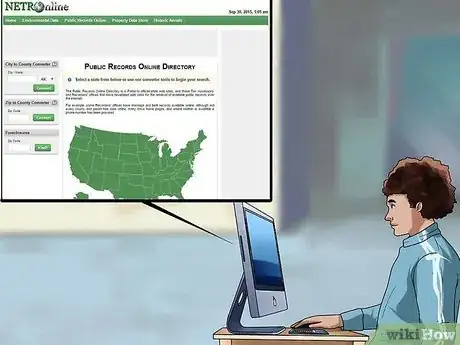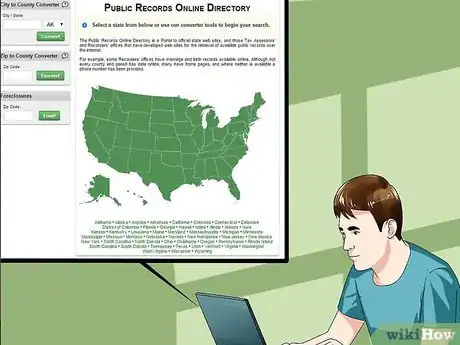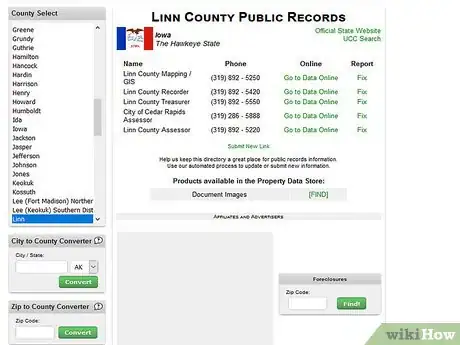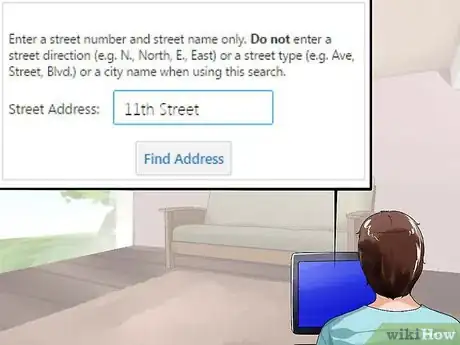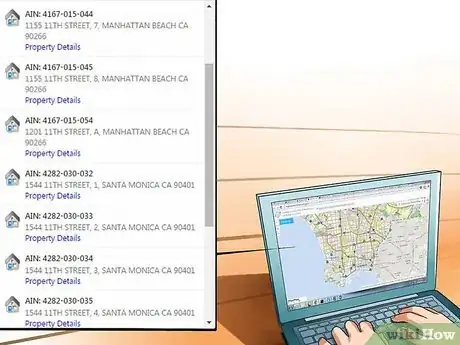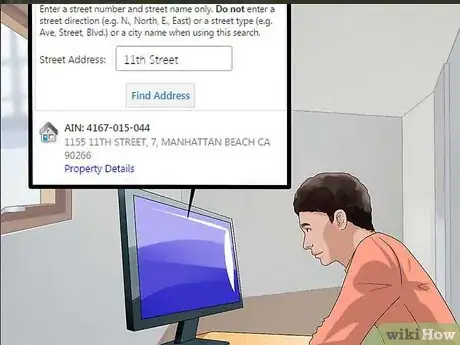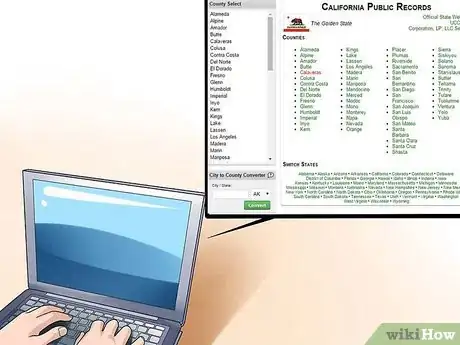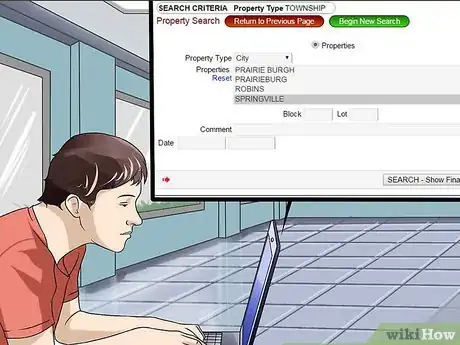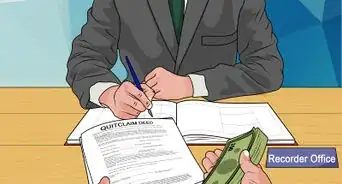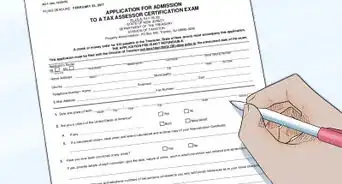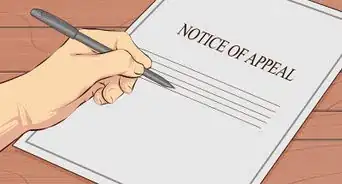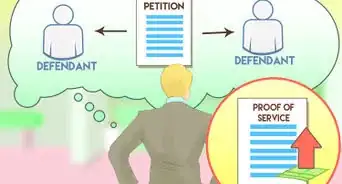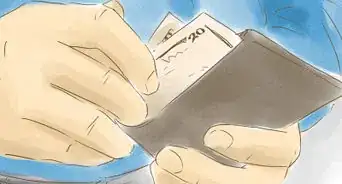This article was co-authored by Clinton M. Sandvick, JD, PhD. Clinton M. Sandvick worked as a civil litigator in California for over 7 years. He received his JD from the University of Wisconsin-Madison in 1998 and his PhD in American History from the University of Oregon in 2013.
There are 9 references cited in this article, which can be found at the bottom of the page.
This article has been viewed 293,312 times.
If you are purchasing real property (a.k.a., a home or land) or using your home as collateral on a loan (e.g., getting a mortgage), chances are you will have to conduct a title search. When you conduct a title search, you are in fact looking back through the history of a piece of property. A title search can reveal, among other things, property sales, encumbrances, and tax delinquencies. You can always conduct a title search in person at your county recorder's office. However, nowadays, it is also relatively easy to conduct a title search online. To conduct an online title search, you will need to gather certain information about the property in question and conduct an online search using that information. Follow the directions in this article to successfully complete an online title search.
Steps
Understanding Title Searches
-
1Know when you need to conduct a title search. Title questions will always come up in two common situations. If you are in one of the following situations, you should read this article to learn more about conducting an online title search.
- First, you will need to analyze title when you are purchasing property from someone else (for instance buying a home).
- Second, you will need to analyze title when you are using your own property as collateral (for instance when you are obtaining a mortgage).
- Apart from the two most common scenarios, you might simply want to conduct a title search for your own informational purposes.
-
2Understand what types of documents you can find. When you conduct a title search, you will have the ability to look for, and find, a variety of different documents. With that said, a "title" will not be one of the documents you find. A property title is a comprehensive term referring to the legal rights an individual has to the property in question.[1] Having title to a piece of property means you have ownership rights over that property and you can choose to do what you want with it.[2] Therefore, a title is not a tangible item; it is only a legal term conveying your rights to something.[3] You are, however, likely to encounter some or all of the following documents when you conduct an online title search:
- Deeds. A deed is the legal written document that transfers title from one person to another.[4] Deeds are probably the most common document found in title searches and they are valuable for tracing back ownership of a particular property.
- Liens. A lien is a property interest document used by creditors to let everyone know you owe them money.[5] A lien is an important document in a title search because a lien clouds your title. In order to sell or mortgage a piece of property, you must have a clean title, meaning one that is not encumbered by a lien.[6] Therefore, knowing if you have any liens on a piece of property can be important information to know.
- Mortgages. A mortgage is a debt instrument used by banks and individuals in order to buy a piece of property without paying for the whole thing up front.[7] A mortgage is a type of lien, and is therefore an important document to look for during title searches.[8]
Advertisement -
3Know what kinds of information you are looking for. When you conduct an online title search, you are usually trying to answer two very important questions.
- First, you usually conduct a title search to understand who holds valid title to a piece of property. This information can be valuable whether you are trying to purchase a home or use a home as collateral on a loan. You should not buy a house until you know the person you are buying it from is legally able to sell it. Also, a bank will not loan you money for a mortgage until they know you are the rightful owner of the home.
- Second, You want to look at the public land records to see if there are any encumbrances on the land. An encumbrance is a "right or interest that exists in someone other than the owner of an estate and that restricts or impairs the transfer of the estate or lowers its value.[9] Examples of encumbrances include liens, easements, covenants, mortgages, or unpaid taxes.[10] This information is also valuable when you are trying to purchase a home or use a home as collateral on a loan. You should not buy a home until you know that title is free from encumbrances. Also, a bank will be interested in what encumbrances your title has before they offer to loan you money for a mortgage.
Gathering Basic Property Information
-
1Find the property's address. The first step in gathering information is to find and write down the property's address. A property's address is probably the most common way to identify a piece of property and it can be incredibly useful when you are conducting a title search. To find a property's address, you can take a trip to the property in question and look at the address on the home. If you are not able to conveniently get to the property, you can use Google Earth or you can conduct a Google Search. You can also ask people familiar with the property if they may have the address on hand.
-
2Locate the name of the person who owns or has owned the property. If you are purchasing a piece of property from someone else, this step should be easy. However, if you are planning on conducting a title search for informational purposes and you do not have access to names, you will have to search for those names. To do this, try using this public records online search engine. Here, you can search for public records, which may include the names of people owning a particular piece of property, by clicking on your state and your county.[11]
- If you are going to be searching for deeds during your title search, it will also help if you know whether the person whose name you have is a grantor (person transferring an interest in property) or grantee (person accepting a property transfer).
-
3Find a range of dates to narrow your search. In order to narrow your search and get the best results possible, think about the documents you want to search for and when those documents were probably recorded. The process of recording a property document involves filing that document with the county recorder's office. If you know when a particular document was recorded, it will help you find that document quicker when you conduct your online title search.
Finding a Parcel Identification Number
-
1Understand parcel identification numbers. A parcel identification number, also known as an assessor's identification number, map number, block number, or lot number, is one of the most valuable pieces of property identification you can have. This number is designated by the county where the property is located and used on all documents that are recorded about that specific piece of property.[12]
- Each specific piece of property in every county is given a unique identifying number. If you can find this number for the property in question, you will have a much easier time conducting a successful title search.
-
2Visit the county assessor's website. The first step in finding a parcel identification number is to track down the county where the property is located. Once you know this, you will visit that county's assessor's website.[13] To find a county assessor's website, you will simply visit this public records website. Once there, you will click on the state where your property is located. You will then be given a list of counties in that state. Simply click on the county where your property is located and a screen like this will appear. That screen will list all of the county's websites that contain public records. Because you are looking for a parcel identification number, you will need to click on the link for your county's assessor's office.
-
3Navigate to the property search function. Once you are at the county assessor's website, you will have to find its property search function. Each county's website will be different.
- In Greenville County, South Carolina, the assessor's property search function can be found here.
-
4
-
5Find your property. Once you type in an address and click search, a list of properties will appear. If you typed in a specific address, hopefully only the property in question will come up. Once you find the property you are looking for, click on it.
-
6Look for your parcel identification number in the property description. When you find the property in question and pull up that property's information, one of the first things that will appear will be the property's identification number.[16] Write this identification number down and keep it handy.
Conducting Your Title Search
-
1Visit the county recorder's website. After you have gathered all of the important information about the property you will be conducting a title search for, you will visit the county recorder's website for the county where the property is located. To find your county recorder's website, click on this public records website. Once there, you will click on the state where your property is located. A list of counties in that state will pop up and you will need to click on the county where your property is located. The next screen will look something like this. Click on the county recorder's website.
-
2Navigate your way to a property title search. Now that you are at the county recorder's website, you will need to find out how to conduct a title search. Every county's website is going to be different so you will have look around to find it. If you cannot find what you are looking for, call the county recorder's office and ask for help.
-
3Use the information you have gathered to complete a search. Depending on your county's search parameters, you will use some or all of the information you have gathered to look for documents that have affected title to the piece of property in question.
- For example, in Linn County, Iowa, you can search by name, document type, date, address, or parcel number.[17]
- In Ventura County, California, you can only search by name and date.
-
4Analyze your findings. Once you find a particular document, you can look through it to gather the information you need. Keep searching for documents until you are satisfied with the information you have.
References
- ↑ http://legal-dictionary.thefreedictionary.com/title
- ↑ https://www.rocketlawyer.com/article/whats-the-difference-between-a-roperty-deed-and-a-title-ps.rl
- ↑ https://www.rocketlawyer.com/article/whats-the-difference-between-a-roperty-deed-and-a-title-ps.rl
- ↑ https://www.rocketlawyer.com/article/whats-the-difference-between-a-roperty-deed-and-a-title-ps.rl
- ↑ http://www.nolo.com/legal-encyclopedia/what-property-lien.html
- ↑ http://www.nolo.com/legal-encyclopedia/what-property-lien.html
- ↑ http://www.investopedia.com/terms/m/mortgage.asp
- ↑ http://www.investopedia.com/terms/m/mortgage.asp
- ↑ http://legal-dictionary.thefreedictionary.com/encumbrance
- ↑ http://legal-dictionary.thefreedictionary.com/encumbrance
- ↑ http://publicrecords.netronline.com/
- ↑ http://www.ehow.com/how_8213576_map-number-property.html
- ↑ http://www.ehow.com/how_8213576_map-number-property.html
- ↑ http://www.ehow.com/how_8213576_map-number-property.html
- ↑ http://www.greenvillecounty.org/appsAS400/RealProperty/
- ↑ http://www.ehow.com/how_8213576_map-number-property.html
- ↑ http://cotthosting.com/ialinn/LandRecords/protected/SrchQuickProperty.aspx
About This Article
To search for a property title on the internet, start by visiting the county recorder’s website for the county where the property is located. Then, click on the property title search button on their website. Using this search function, you can input different information you have on the property you want to find, such as the names of previous owners, the address, or the parcel identification number. Once you find the property title you’re searching for, you can look through the document to gather any information you may need. To learn how to find a parcel identification number for a property, read more from our Legal co-author!




